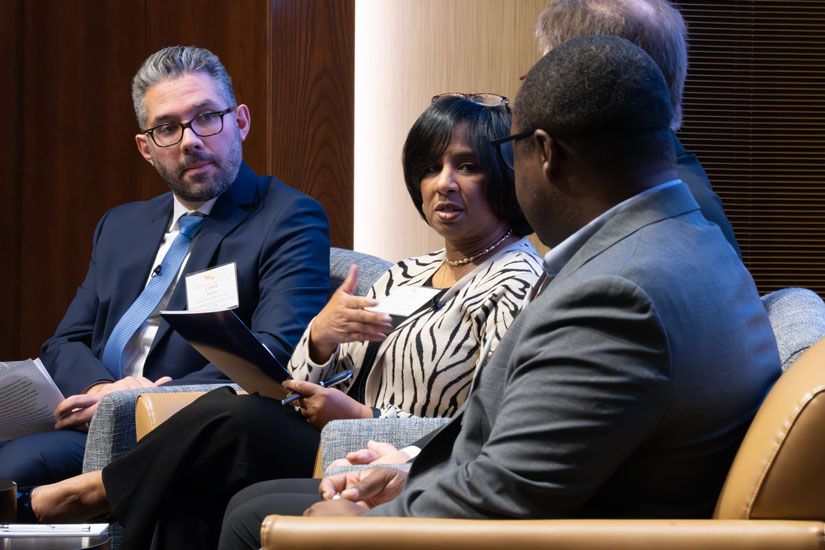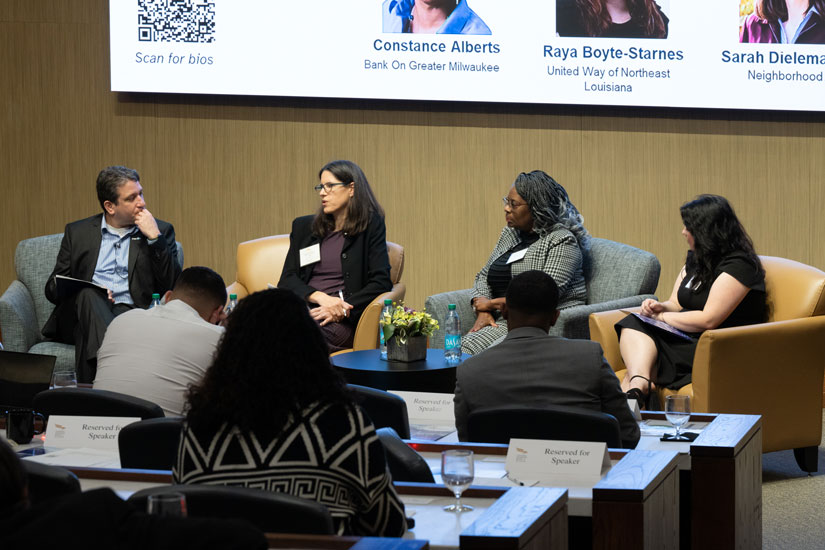A Picture of Banking Access and Financial Inclusion in the U.S.
Americans’ access to basic banking services improved last year, with a new report from the Federal Deposit Insurance Corp. (FDIC) finding that the share of unbanked U.S. households has continued to decline. Unbanked households don’t have a checking or savings account at a bank or credit union, and the report estimated that in 2023 there were 5.6 million of them across the nation.
“In 2023, there were 5.3 million more households in the banking system than we would have expected to see if the unbanked rate had remained where it was in 2011,” said Keith Ernst, associate director in the Division of Depositor and Consumer Protection at the FDIC.The FDIC report uses “rate” to refer to the percentage or share of households. “So it’s a sizable movement.”
Ernst made his remarks during a panel discussion at a daylong event hosted in November by the St. Louis Fed’s Community Development department. The event brought together bankers, community organizations, Federal Reserve staff and others to discuss innovations and best practices for promoting financial inclusion. Steven Brown, director of insights and evidence for the Aspen Institute Financial Security Program, and Lisa Locke, a community development advisor at the Federal Reserve Bank of St. Louis, joined Ernst on the panel, which was moderated by St. Louis Fed Data Scientist Lowell Ricketts.
While the rate of unbanked households has been cut nearly in half over the last decade, Ernst noted that concurrent developments have made questions of banking access more complex. For example, the hundreds of financial institutions offering low-cost Bank On accounts in 2023, up from just a handful in 2013, have helped bring down unbanked rates. At the same time, nonbank online payment services like PayPal, Venmo or Cash App, which existed in some form in 2013 but were not prevalent in the way they are today, offer consumers an increasing array of choices for making payments.
Data on the State of Banking Access and Financial Inclusion
As the following figure shows, the rate of unbanked households nationally dropped from 7.7% in 2013 to 4.2% in 2023, and it remains at its lowest level since the FDIC began issuing its report in 2009. Over the same period, the rate of underbanked U.S. households—those that had a bank or credit union account but primarily relied on nonbank products and services to meet their financial needs—fell from 21.1% to 14.2% (which still represents millions of households—19 million in 2023).
The Rates of Unbanked and Underbanked Households Continue to Decline

SOURCE: FDIC National Surveys of Unbanked and Underbanked Households.
NOTES: The FDIC conducts its National Survey of Unbanked and Underbanked Households biennially. Estimates for 2017 may not match previously published estimates because missing values in the 2017 data have been replaced with imputed data.
So what accounts for the decline in the rate of unbanked households?
About two-thirds of the downward trend in the rate of unbanked households can be explained by improvements in socioeconomic factors like income, educational attainment and homeownership, which are often associated with bank account ownership, Ernst said.
He added that potential explanations for the remaining one-third of the decline could be a combination of:
- Advances in technology, such as the rise of mobile banking
- Developments within the banking system, such as the spread of low-fee Bank On products that lower barriers to opening an account
- The work that community-based organizations are doing to increase awareness about the need to connect people with financial products and services that fit
The number of households using mobile banking as the primary way they access their accounts has risen almost ninefold in the past decade, according to the 2023 FDIC National Survey of Unbanked and Underbanked Households (PDF). Today, it’s the most common way people bank. Ernst said that the day-to-day information mobile banking provides can be valuable to someone managing a relatively low-balance account.
“We’ve seen accounts that are responsive to the consumer perspective,” Ernst said. “I think we’re hopeful the account structures in place will be more sustainable for consumers, that the convenience and value they derive from those banking relationships will help them weather life events that could otherwise cause them to exit the banking system.”

The St. Louis Fed’s Lowell Ricketts (left) moderates a panel discussion on the state of banking access with (from left) Lisa Locke of the St. Louis Fed, Keith Ernst of the FDIC and Steven Brown of the Aspen Institute Financial Security Program during a Nov. 14, 2024, event hosted by the St. Louis Fed’s Community Development department.
Banking Access and Demographic Characteristics
While the overall rate of unbanked households has declined recently, lower-income, less-educated, disabled, single-parent, and Black and Hispanic households are significantly more likely to be unbanked, the FDIC report found. For example, in 2023 the unbanked rates among Black, Hispanic, and American Indian or Alaska Native households were 10.6%, 9.5% and 12.2%, respectively, compared with 1.9% for white households.
Age also seems to play a role in banking access. As Americans get older, they are more likely to have a bank account. A decade ago, the unbanked cohort was disproportionately young, Ernst said. The unbanked population in 2023 still skewed young, he added, but it was much more reflective of the distribution of the population as a whole. (See the figure below.)
The Unbanked Rate for Young Households Has Fallen toward That of Other Age Groups

SOURCE: FDIC National Surveys of Unbanked and Underbanked Households.
NOTES: The FDIC conducts its National Survey of Unbanked and Underbanked Households biennially. Estimates for 2017 may not match previously published estimates because missing values in the 2017 data have been replaced with imputed data.
Improving Banking Access and Building Financially Healthy Communities
The FDIC report shows that, in 2023, one-third of unbanked Americans gave fees or minimum balance requirements as the main reasons they didn’t have an account. That makes the Bank On movement, which works to connect low- and moderate-income individuals to the financial mainstream, an important component of banking access and financial inclusion.
The reach of Bank On products has expanded considerably over the last decade, with nearly 500 financial institutions now offering certified accounts, said the St. Louis Fed’s Locke, who serves as the lead relationship manager for the Bank On National Data (BOND) Hub. As of December 2023, more than 11 million Bank On-certified accounts were open and active in more than 37,000 U.S. ZIP codes, according to the latest BOND Hub report. That’s a Bank On presence at more than 46,000 bank branches and in approximately 89% of ZIP codes nationwide.
There are more than 100 Bank On coalitions—partnerships among nonprofits, financial institutions, local governments and others—operating across the country. These coalitions maintain a variety of programs designed to promote Bank On accounts and other means of financial inclusion. Looking forward, educating communities and financial institutions alike about the value of Bank On products will continue to be important, Locke said.

Bank On coalition leaders share best practices and information about their programs during a panel discussion hosted on Nov. 14, 2024, by the St. Louis Fed’s Community Development department. David Rothstein of the Cities for Financial Empowerment Fund (left) moderated the conversation with (from left) Sarah Dieleman Perry of Neighborhood Allies, Constance Alberts of Bank On Greater Milwaukee, and Raya Boyte-Starnes of the United Way of Northeast Louisiana.
In 2023, more than $174 billion was deposited into Bank On accounts, according to the 2023 BOND Hub report. Data on the number and amount of debit transactions, deposits and withdrawals show that Bank On account holders use them in their everyday financial lives, suggesting they value and use the accounts for regular transactions.
A Broader View of Financial Inclusion
A bank account—specifically a transaction account, such as a checking account—is a fundamental point of entry to the financial system for many. Besides providing a place of financial stability from which to build, bank accounts are often an important initial step in gaining access to credit and a range of other products and services.
“For us, thinking about financial inclusion means that all people get access to the types of accounts and types of services that are going to be to their use and benefit,” said the Aspen Institute Financial Security Program’s Brown. “We look across access, use and benefit, because it’s not enough if households have access to something, but the services are expensive or they’re not meeting what they need from them.”
Brown noted that, in addition to looking at whether households have a transaction account, considering measures around savings, credit usage, long-term investing and retirement, and insurance is important for a more holistic view of households’ financial well-being.
Among unbanked households, about one-third primarily use a combination of prepaid bank or debit cards and online payment services to meet their financial needs, while about two-thirds primarily use cash, Ernst said. And despite having a bank account, underbanked Americans still primarily use nonbank products and services like payday loans and check cashing services. According to Brown, this may indicate that the financial services these consumers want are broader than the accounts they hold, offering another way to look at financial inclusion.
“What are the aspects of people’s day-to-day lives, the potential financial needs, that aren’t being satisfied by the account you’re using to pay for groceries or your bills? Why do they have to go look for alternative financial services, usually at greater cost?” Brown said. “I think those are real questions worth exploring.”
Note
- The FDIC report uses “rate” to refer to the percentage or share of households.
This blog explains everyday economics and the Fed, while also spotlighting St. Louis Fed people and programs. Views expressed are not necessarily those of the St. Louis Fed or Federal Reserve System.
Email Us


